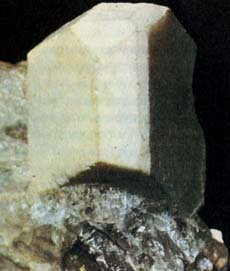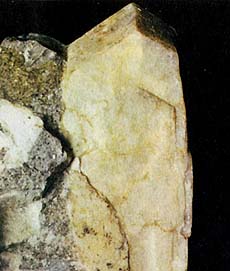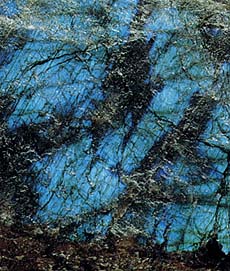Feldspars (silicates): Plagioclase others



Plagioclase (in translation from Greek "obliquely splitting") is a series of mixed crystals from sodium aluminosilicate - albite to calcium aluminosilicate anorthite. The hardness is 6-6.5. The density is 2.6-2.8. Glitter is glass, in albite on the planes of cleavage is pearly. Opaque, less visible. Colors: grayish-white, less often red, yellow or colorless. The line is white. Fracture stepped-uneven. It's fragile. Cleavage is perfect. Tabular single crystals (trigonal syngony) are rare, often polysynthetic twins according to the albite law, composed of thin plates. It is ubiquitous; Collection material - in Switzerland, Norway, the Urals.
Oligoclase
Contains 70-90% albite and 10-30% anorthite component. Forms masses with cleavage and tabular crystals. The color may be gray, yellow, brown and reddish. A variety of oligoclase, very popular as an ornamental stone due to its bright and brilliant iridiscence, was called "sun stone" or aventurine. Beautiful individual crystals (rare) come from the states of California and New York, Sweden and Russia.
Melts with difficulty. Behavior in acids Dissolves with difficulty. Greenish, reddish white, colorless. The shape of the crystals. Columnar, thick-plate, polysynthetic twins are common. Crystal structure. Silicate with an infinite three-dimensional frame (SiAl) O4. Class of symmetry. Triklinno-pinacoidal - 1. Cleavage. Very perfect in the basis (P), good at the end face of the pinacoid (M) and the prism (F). Aggregates. Granular, dense.
Andesine
Contains 50-70% albite and 30-50% anorthite component. It is represented by tabular crystals or masses with cleavage. The color is white and gray, gloss is glass. Contained in igneous rocks - andesites and andesite basalt. Discovered in Greenland, Norway, California, etc .; Individual crystals of this plagioclase are very rare.
Melts with difficulty. Behavior in acids: hardly soluble. Shimmering (sun stone, or aventurine) due to inclusions of the smallest scales of hematite, sometimes with a golden ebb (semiprecious stone). The shape of the crystals. Columnar, thickly toothed. Crystal structure. Frame lattice with a continuous three-dimensional frame (SiAl) O4. Class of symmetry. Pinacoid - 1. Cleavage. Perfect in the basis of (001), the mean over the finite face and along the faces of the prism (010). Aggregates. Granular, dense.
Aventurine feldspar, or solar stone. The name of the stone is given for its similarity to a randomly open adventurin glass (Italian a ventura - case) with thin golden sparkles. A sunny stone is called because of the golden sparks that fill it. Flicker usually in reddish, less often in greenish or blue tones is caused by iridescent glimpses from thin lamellar inclusions of hematite, goethite or lepidocrocite. Deposits are known in the USA, India, Canada, southern Norway, the CIS (the Urals). It is processed by a table or cabochon. It can be confused with aventurine glass or with aventurine quartz.
Labradorite (Labradorite)
Contains 3-50% albite and 50-70% anorthite component. It is a component of igneous rocks, which are poor in silica. On the island of San Paul and in general on the Labrador are met magnificent crystals, very popular as an ornamental stone due to the most beautiful iridiruyuschim effect due to the lamellar structure of this mineral, as well as the smallest inclusions of titanite, magnetite and ilmenite. Rich stocks in Ukraine.
Labrador is a plagioclase, named after the Labrador Peninsula, where it was discovered in 1770. The color of the opaque Labrador from dark gray to gray-black, sometimes dark blue. The best varieties of it have an iris, reminiscent of the ebb of the "cat's eye" (Greenlandic, St. Paul's Island) or "peacock feather" (Indian). Irisation can be continuous, but more often local, and by the nature of extinction - wavy and mosaic, according to the geometry of the patterns - capricious, patchy, zonal. The colors of the iris are also different - one-, two- and three-color in blue, green, yellow and even red tones. In Burma, sometimes there is a labrador with iris, as in a moonstone. It is called a black moonstone. And in Ukraine and Finland, a beautiful variety of Labrador is known - spectrolite.
The most appreciated are labradors, which cast all colors of the spectrum (spectrolite). The reason for this effect is the interference of light in the finest plagioclase plates of different composition, from which a labrador is built. Unstable when squeezing. Deposits are known in Canada (Labrador, Newfoundland), as well as in Madagascar, Mexico, CIS (Ukraine), USA. In the early 40-ies of the XX century near Iliyarvi (Finland) was opened Labrador, which casts all colors of the spectrum, which was called spectrolite. Used for making beads, brooches, rings and other art craft items. From Madagascar comes the labrador with a very bright blue tint. In New South Wales (Australia), transparent, colorless and yellowish brown labradors were found, suitable for cutting.
The shape of the crystals. Columnar, thick-plate (crystals are rare). Crystal structure. Silicate with an infinite three-dimensional frame (SiAl) O4. Class of symmetry. Pinacoid - 1. Cleavage. Perfect in basis (P) (001), clear along the end face (M) (010) and along the prism (T). Aggregates. Granular, dense.
Bitovit
The last in the series of plagioclases is bitanovit, which contains 10-30% albite and 70-90% anorthite component. In the form of clear crystals, bitonite is exceptionally rare, but it is quite common as a component of rocks of the gabbro type, such as anorthosites (no photo).
- Ghetchellit - "New Almaden blend" - arsenide and antimony sulfide (modern sulfosol)
- Antimony is a toxic metal (semimetal) , widely used in metallurgy, medicine and engineering
- Zirconium - a rare and undiscovered metal and the most dangerous precious stone in oxide and salt
- Gold - yellow dangerous and poisonous metal of modern accurate digital and cable technologies
- Sulfur is a golden-yellow toxic substance and a sign of active volcanic activity
- Cadmium is an undisputed toxic silvery metal unknown to a wide range of people
- Lead - a toxic gray imitator of metallic silver and toxic metal blende
- Arsenic is a classic poison of medieval and modern poisoners and medicine in medicine
Poisonous and radioactive dangerous stones and minerals
** - poisonous stones and minerals (mandatory check in the chemical laboratory + explicit indication of toxicity)
** - radioactive stones and minerals (mandatory check on the standard dosimeter + ban on open sales in case of radioactivity exceeding 24 milli / g / h + additional measures of population protection)
Catalog of minerals and semi-precious stones of the world by groups
** - poisonous stones and minerals
** - radioactive stones and minerals


Comments
When commenting on, remember that the content and tone of your message can hurt the feelings of real people, show respect and tolerance to your interlocutors even if you do not share their opinion, your behavior in the conditions of freedom of expression and anonymity provided by the Internet, changes Not only virtual, but also the real world. All comments are hidden from the index, spam is controlled.